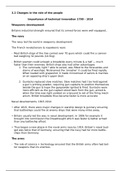3.2 Changes in the role of the people
Importance of technical innovation 1790 - 1914
Weaponry development
Britains industrial strength ensured that its armed forces were well equipped..
The navy
The navy led the world in weaponry development
The French revolutionary & napoleonic wars
- Most British ships of the line carried over 70 guns which could fire a cannon
ball weighing 32 pounds (14.5kg).
- British seamen could unleash a broadside every minute & a half — much
faster than their enemies. British ships also had other advantages:
1. The carronade, light * able to swivel, was fitted to the forecastles and
sterns of warships. Nicknamed the ‘smasher’ it could be fired rapidly.
When loaded with grapeshot, it made mincemeat of sailors & marines
on an opposing ship’s upper deck
2. Gunlocks replaced slow matches. Slow matches had t be held against
a gun’s priming powder, requiring gun captains to position themselves
beside the gun & hope the gunpowder ignited & fired. Gunlocks were
more efficient as the gun captain stood back from the gun, aimed &
when the time was right yanked on a lanyard to set of the firing mech-
anism. British broadside thus became faster & more accurate
Naval developments, 1815-1914
• After 1815, there were major changes in warship design & gunnery ensuring
that battleships could fire at enemy ships that were many miles away.
• Britain usually led the way in naval development. In 1906 for example it
brought into commission the Dreadnought which was faster & better armed
than any battleship afloat.
• Thus began a new phase in the naval arms race.by 1914, Britain’s naval bud-
get was twice that of Germany, ensuring that the navy had far more battle-
ships than Germany.
The army
- The role of science + technology ensured that the British army often had bet-
ter weapons than its enemies





